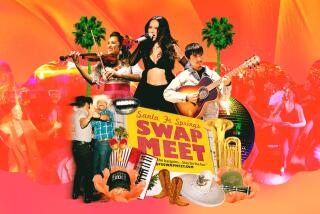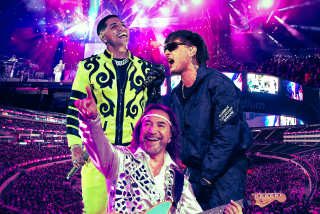Songs and Salsa : Boyle Heights Cafes Spice Up Food With Live Latino Music
The couple apparently had been squabbling for a while by the time they reached a restaurant favored by the Spanish-speaking in predominately Latino Boyle Heights for an early morning meal of tacos de carnitas.
When the woman threatened to leave--”I’ve had enough of YOU,” she shouted in Spanish--the boyfriend quickly motioned to a trio of singers at another table and requested a Mexican song about doomed love, “Una Aventura Mas.” The girlfriend seemed miffed by the gesture, but said nothing as the trio, wearing white, embroidered guayabera shirts, broke into song:
“I know that I am one more adventure for you . . . (because) you will forget me after tonight . . . . I know that I am a fleeting illusion for you . . . a whim of the soul. . . .”
By song’s end, she had changed her mind. She smothered the boyfriend with kisses and cried out, “Oh no, I’ll never forget you. I’ll never leave you. . . . “
The song did the trick, as it has for the last 30 years on the Eastside.
The incident at La Azteca on Brooklyn Avenue is a typical slice of life seen nowhere else in Los Angeles: Roving musical groups of mostly Mexican influence--mariachis, soloists, trios and even ragtag norteno groups that don’t even have names--on a nightly search for lovers and lonely hearts who will pay for a song.
For $3 to $5 each, tunes ranging from ballads of torment to loud, blaring marching music can be ordered from the more than 50 groups that visit the restaurants and bars of Boyle Heights. Neither a loud jukebox nor a belligerent bar patron seems to dissuade the groups from walking through any establishment in hopes of a request.
“I’ll go just about anywhere to sing a song . . . as long as they pay,” said Jesus, 19, who said he recently formed a trio.
Although there is no official explanation of why other parts of Los Angeles don’t also have musicos working the streets there, many Eastside residents seem to think Boyle Heights’ traditional role as the first U.S. home for many recent arrivals from south of the border makes it fertile ground for the roving musicians.
“We sing mostly Mexican music and the people who live here were born in Mexico or have family there,” said one musician. “I used to sing in Wilmington and in Santa Ana, but this is the best--close to downtown and close to my people’s heart. . . . “
On weekend evenings, some of the groups can be seen tuning guitars on the sidewalks as early as 4:30 p.m. And on weeknights, the sight of groups wearily walking home on unlit streets well past 2 a.m. is commonplace.
“It’s part of the ambiance of being in this part of town at night,” said Dr. Dale Norman, a clinical psychiatrist from Santa Monica who frequently enjoys dinner with friends at La Parrilla restaurant on Brooklyn Avenue. “You won’t find singers like this anywhere else in L.A. I especially look forward to hearing “Sin Anos” (“Without Years”).
Indeed, restaurant operators report that many patrons come to the eateries along Brooklyn and Evergreen avenues and First and Soto streets specifically to take in the Mexican music.
“Oh, they just love it,” said Carmen Salas, who operates La Parrilla. A waitress at the nearby El Apetito restaurant added, “You just don’t know what Mexican music is until you’ve heard these people.”
“That’s right,” mused Francisco Hernandez, leader of the norteno group, Los Rinches del Sur (Rangers of the South). “Mexican music isn’t characterized by men, dressed up in charro outfits, screeching at the top of their lungs.”
The range of repertoires is much wider, he said. For example, there is the accordion-accompanied norteno music, a polka-like sound from northern Mexico. Gentle guitar-strummed romantica ballads composed by Jorge Negrete, Augustin Lara and others, and fast-paced, Caribbean-influenced tunes from southern Mexico, especially from Veracruz.
And there’s the ever popular ranchera music of the likes of Vicente Fernandez, best presented by mariachi groups, complete with violins and trumpets.
Even for Anglo Ears
For the Anglo ear, there are the easy standards known by all the groups-- “El Rancho Grande, “ “ La Cucaracha” and “Guantanamera” among them.
And for most of the musicos-- most of whom claim to know 2,000 songs--there isn’t a song that they can’t sing. Well, almost.
In El Apetito recently, a disagreement erupted over the lyrics to a song by Jorge Negrete, the Mexican screen idol of the 1940s and 1950s. “No, no, no,” insisted a member of one trio. “It goes like this, ‘. . . Da-de-da . . . de daaaaaaaaaaaaaahhh’ ”
“You don’t even know what you’re talking about,” said a member of a norteno group. “It’s like this, ‘teeeeeeeee-teeeeeeee . . . da-da. . . .’ ”
A stout patron, munching tortilla chips and salsa, shook his head in disgust and concluded, “Well, I’m not paying for this da-de-da or teeeeeeee-teeeeeeeee. Go argue somewhere else.”
For Homesick Mexicans
Whatever their style, the songs that fill Boyle Heights are more often than not Mexican musicians singing about Mexico to homesick Mexicans. Groups of young men who congregate in some of the Eastside’s bleakest-looking bars are among the best audiences for songs.
Often, members of some groups don’t even have to say anything when they enter a bar. A few strums on the guitar signal the eager patrons to unplug the jukebox.
“Well, what will it be, muchachos ?” the leader of one group asked some customers at Mitla’s Cafe on First Street on a recent night.
“It doesn’t matter,” a patron wearing a Chevy baseball-style cap said with a wave of the hand. “Just play.”
Hearing that, one scruffy-looking factory worker, sipping beer at another table in honor of a recent pay raise, bellowed at the group for songs of Mexico City.
Boost Their Regions
“Que viva la capital!” the scruffy one kept yelling as the group obliged him with several songs. A companion retorted, “Forget the capital. Viva Chihuahua!”
Playful shouting back and forth ensued, but no dispute occurred. Rather than favor one region over another, the group picked a song that allows any region in Mexico to be dropped into the lyrics:
“I am here in the north . . . lonely for you, looking for money that will pay for our dreams. I will always come home to (. . . Chihuahua . . . Jalisco . . . Michoacan . . . Guanajuanto . . . Veracruz . . . Tijuana!!!)”
Making a living as a musician on Eastside streets, however, isn’t always fun.
The groups rarely make $100 for a night’s work. Most are lucky if they make $50.
‘A Little Something’
“There are weeks when we don’t make anything,” said Hernandez, leader of Los Rinches del Sur. “Then there are weeks when we’ll make a little something. But usually, it’s not enough to pay rent, buy food and all that.”
To save on expenses, many musicians, some of them recent arrivals from Mexico, stay with relatives or share a small apartment with other musicians in the area. “Not only is it cheaper but it also makes practicing easier,” said Mario, a trumpet player with a mariachi group.
Members of one norteno group, Los Dorados del Norte (The Golden Ones of the North), supplement their nightly musical forays with daytime construction jobs. “I’ve been in construction in downtown Los Angeles for a few years,” said one member, Jose Luis Hernandez. “It’s tiring. But when I sing, I forget about being tired. I love to sing. But I’d also love to keep paying rent.”
Some groups come directly to the streets of Boyle Heights from their daytime jobs instead of going home to change clothes. Members of one mariachi group, Mariachi Los Trabajadores (The Workers), wear an assorted array of khaki work shirts, soiled running shoes and oddly colored polyester pants.
The only matching apparel worn by each member is a black mariachi-style jacket.
Boosting Business
In hopes of attracting jobs, members of most groups are quick to pass out business cards-- “Musica para toda ocasion” (“Music for every occasion”). And if the group has no cards, a napkin will do.
More often heard, however, is the statement from many musicians that working the streets of Boyle Heights is the only work they can do.
“You see, we are musicians,” said Jose Munoz, a member of a trio called Los Conquistadores. “That’s all we know. We’ll go to these places and that’s all we do.”
Armando, the leader of the nameless trio that rescued the boyfriend in La Azteca, nodded his head in agreement. “It’s all we do and I like it,” he said.
“One night, this gringo asked us to sing ‘New York, New York,’ Well, we don’t know that song. And I asked him, ‘Will you settle for ‘La Bamba?’ “
He did.
More to Read
Eat your way across L.A.
Get our weekly Tasting Notes newsletter for reviews, news and more.
You may occasionally receive promotional content from the Los Angeles Times.










